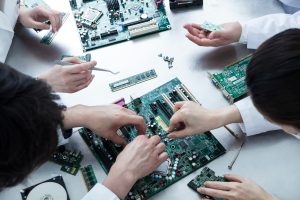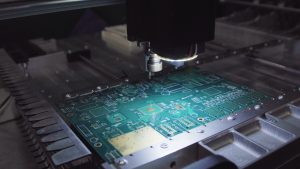Printed circuit boards (PCBs) are essential components in nearly all modern electronics. They provide the foundation and circuitry to connect various electrical components into functioning devices and products. With the rapid growth of electronics across industries, there is increasing demand for high-quality and reliable PCBs. Choosing the right PCB assembly manufacturer is critical to getting boards fabricated correctly and delivered on time. The PCB manufacturing process involves many complex steps of design, testing, and production. Not all manufacturers have the same capabilities and quality standards.
Tips to choose a PCB assembly manufacturer:
Quality
The quality of the PCBs you receive is paramount, as it impacts the performance, reliability, and lifespan of your end product. When evaluating PCB manufacturers, look for the following signs of quality:
- Materials used: High-quality PCB manufacturers use FR-4 glass epoxy laminate materials that are UL-certified for safety and reliability. The copper layers should meet thickness specifications.
- Precision: Quality PCBs maintain tight tolerances of 8 mils or lower. This precision ensures components fit together correctly.
- Reliability testing: Reputable manufacturers conduct reliability tests like HAST, thermal shock, and cycling to validate the PCBs withstand vibrations, temperature changes, and time.
- Solder mask and legend quality: A quality solder mask provides insulation and prevents solder bridges. Legends should be printed for part numbers and identifiers.
- Plating integrity: Quality plating of gold, nickel, palladium, or other finishes prevents corrosion and protects circuits. Proper plating thickness avoids solder leaching over time.
- Layer-to-layer registration: Tight process controls ensure proper alignment between layers, preventing shorts or open circuits.
- Control of impedance: Matching impedance requirements across traces and planes prevent signal reflection and loss.
- Consistent quality: Rigorous quality management standards like ISO 9001 ensure consistent quality across all PCBs.
While higher quality PCBs cost more initially, they save long-term costs and prevent device failures in the field. Investing in a high-quality PCB manufacturer can improve your product’s lifespan, performance, and reliability.
Capabilities
When evaluating PCB manufacturers, you’ll want to make sure they can support your specific project requirements in terms of capabilities. Here are some key considerations:
- Prototyping vs. production – Some manufacturers specialize in quick-turn prototyping with fast lead times, while others are set up for higher volume production runs. Understand each manufacturer’s sweet spot.
- Board sizes – The manufacturer should be able to produce boards of the sizes and form factors you need. Some specialize in smaller boards and others in larger panels.
- Layer count – How many layers can the manufacturer reliably produce? Some top out at 6 layers, while others can do 20+ layers. More layers add complexity.
- Materials – What types of board materials are supported? Common options include FR-4, high frequency, high speed, metal-backed, and flexible circuits. Not all manufacturers work with all materials.
- Tolerances – The equipment and processes will dictate the attainable tolerances, which can impact costs. Know what tolerances you require.
- Finishes – What plating and finishing options are available? This includes pads/traces, masking, silkscreen, solder mask, ENIG, immersion silver, HASL, and more.
- Testing – The testing capabilities should cover electrical testing, bare board testing, flying probes, and AOI.
Understanding the manufacturer’s capabilities in these areas will help you find one that is a good match for your particular PCB project requirements. Be clear on your needs and verify they can be met.
Lead Times
When choosing a PCB manufacturer, lead times are a major consideration. Lead time refers to the amount of time it takes from when the order is placed to when the finished PCBs are delivered. Typical lead times for PCB manufacturing can range from 24 hours for quick-turn prototypes to over a month for high-volume production runs.
Several factors affect PCB lead times:
- Board complexity – More complex boards with dense component layouts or advanced technologies like HDI take longer to manufacture. Simple boards can be produced much faster.
- Production volume – Low-volume prototype orders generally have faster lead times than full production runs of thousands of boards.
- Inventory – Manufacturers who keep certain materials in stock can reduce lead times compared to building from scratch.
- Location – Domestic manufacturers will typically have shorter lead times than overseas, due to transit time for shipping.
- Workload – Lead times are longer when a manufacturer’s factory is near full production capacity.
- Expedited services – Many manufacturers offer expedited services for a premium fee to reduce lead times when needed. Typical expedite fees are 25-50%.
When evaluating PCB manufacturers, look for information on their typical lead times for your type of board. Also, ask about their on-time delivery record – good manufacturers should be on schedule over 95% of the time. Avoid vendors with a history of substantially late deliveries, as this indicates poor capacity planning or materials shortage problems.
Choosing a PCB assembly manufacturer with short, consistent lead times ensures you get your boards when you need them for your project or production schedule.
Technology
PCB manufacturing technology has advanced significantly in recent years. Choosing a manufacturer that utilizes the latest equipment and techniques can ensure high-quality boards with precise tolerances and features.
Some key technologies to consider include:
- Photolithography – This process transfers the PCB design onto the copper layers. Look for manufacturers using advanced direct imaging (DI) or laser direct imaging (LDI) which provide higher accuracy than older contact printing methods.
- Etching – This removes excess copper after imaging to leave only the desired traces. Manufacturers may use chemical etching or plasma etching. Plasma allows more precision.
- Lamination – This bond the layers together under heat and pressure. Factories use vacuum laminators or hydraulic presses. Vacuum laminators prevent board warpage.
- Drilling – Holes are drilled for component leads to pass through. CNC drilling machines with optical alignment ensure accuracy. Some use lasers for micro-vias.
- Automated optical inspection – Leading manufacturers use AOIs for in-process checks, ensuring any defects are caught early.
- Surface finishes – From basic HASL to immersion silver or gold, the finish impacts solderability and reliability.
- Testing – Electrical, continuity, and functional testing validate board performance. Environmental stress screening simulates long-term use.
The highest-end manufacturers heavily utilize automation through pick-and-place, solder paste screening, and other robotic processes. While reducing labor costs, this also enhances precision and consistency. However, some complex boards still require skilled manual labor. Understand your PCB requirements and find the right mix of automation v/s human attention.



